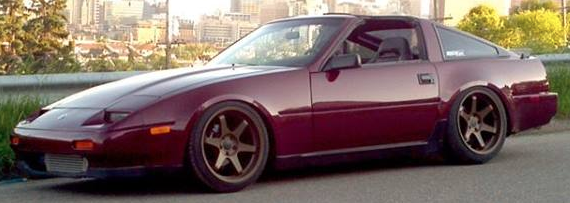Compressor Surge, What it is.
-
 DeleriousZSenior Member
DeleriousZSenior Member- 6874
Compressor Surge, What it is.
Taken from a thread on hybridz… I figured it had some bearing here.. these are two separate posts so take them for what they're worth.
Surge is the phenomenon whereby laminar flow off the wheel is separated, and reverse flows through the compressor.I found this when searching for a good explanation of compressore surge. I am familiar with it as I run across it periodically in my line of work, but I could not quite visualize the impacts.
This is a simplistic, yet practical, explanation of compressor surge that I thought I would share. We know that turbos flutter under surge, some can point to the surge line on a compressor map, but this gives a basic explanation about what is actually occuring in the engine system.
Taken from http://www.passionford.com:
Imagine the way our turbocharger's compressor is driven, right back to basics: The turbine wheel is spun by exhaust gas, utilising also the energy stored in the exhaust gas as latent heat.
This force on the turbine shaft generates torque at the compressor end as they are physically connected. Remember that part as its the key element, Torque
Ok,
Now lets imagine our turbocharger compressing air, forcing it into the engine, the engine is utilising it.. what happens then? Ok, The engine expells it, and our turbine housing pressure goes up accordingly, the torque applied at the turbine wheel increases, increasing the spin speed and compressor efficiency at the other end. Great chain of events!
End Result? boost is climbing nicely.
Ok,
Now imagine this scenario:
The turbo begins to spin, as above, but the compressor wheel is generating more air than we can move and the torque required to spin that huge compressor is not being met? Remember that unless the air is processed by the engine, and expelled as hot, rapidly moving air into the turbine housing, our turbine shaft torque will not increase to spin the compressor faster, and it may well diminish.. our compressor is slowing, braked massively by the compressed air its trying to overcome and increase.....
Result? Compressor starts to slow a little.. (beginings of a compressor stall)
Ok,
So now what?
The engine is still rotating and consuming air, but the turbo has stopped producing an excess, so our engine has now had chance to consume what excess was available and the inlet pressure is now diminishing, the turbine torque is now increasing again…
VERY IMPORTANT:
Remember also that at same time, compressor resistance to spin has also dropped due to housing no longer being as pressurised and as a result, the torque required to spin it has dropped massively..
Boom.. Suddenly the Turbine wheels torque massively exceeds the compressors resistance and the turbo spins to speed in an instant!! Sounds great, rapid boost climb!! The compressors acceerating at over 2G
BUT:
We just hit the same problem again, our huge compressor has made so much boost, so fast, and is trying so hard to push the massive volume or air, that our YB cant use it.... so we start to slow again........
So we went: Fast, slow, fast, slow, or in other words: The turbo is Surging.
As you can imagine, it continues this cycle until it hits the revs your engine consumes all the air.. then your away!!
Please correct where there may be misinformation - TonyD I am looking at you. I searched around Hybridz for an explanation, but nothing came up regarding explaining the phenomenom.
This can accompany any of the above phenomenon. But surge is when the airflow stops and reverses. It can snap off blades. Blow piping joints. Make for an emergency service call worth $275,000!!!
The above discription gets into the forces but is 'muddy' on what it really is.
Centrifugal compressors are VERY influenced by speed of the wheel. The curves change dramatically. In industrial compressors as little as a 2% change in input voltage to the driver can slow the compressor enough to cause massive surging.
It's easier for me to draw a picture of the compressor curve and show on a Pressure versus Flow graph what happens in each instance. This is how I conduct training.
Imagine if you will flow on the horizontal axis, and pressure on the vertical. Zero for each is at the origin, pressure rises as you ascend the vertical axis, flow increases as you traverse the horizontal axis to the right.
The simplest surge line is a slope starting at origin and raising (for argument) at a 30 degree angle to the right. The line represents where the compressor will surge if crossing that line. It is a line denoting the minimum stable flow for the pressure and flow given.
Now, somewhere to the right of that surge curve there will be an 'eyebrow' showing the design curve of the wheel being used. Design point is on this curve. Below that point, you will get more flow for imparted horsepower to a point. Until you reach stonewall, a phenomenon where the wheel, due to the physical size, can not move any more air and flow will stagnate. It is still flowing, but regardless of horsepower applied, the pressure won't rise, and you can't get any more flow. This is in the nebulous region somewhere in or off the lower right of this graph. It is also a curve…but lets skip that!
In a drop throttle condition (assume no blowoff valve), your flow moves to the LEFT rapidly(Instantly) along the horizontal axis while simultaneously RISING along the vertical axis.... This is because the flow requirement from the engine is STOPPED, and the pressure rises simultaneously due to this. Bad Surge that continues to decrease in severity as air is discharged back through the compressor to the intake ductwork and the pressure reaches a point where the flow that exists lets the air reattach itself to the wheel and flow smoothly again through the compressor.
In a lift throttle conditon-say to half throttle, the movement to the left does not move all the way to the vertical origin line, there is still a flow demand, but the compressor will continue making air at high speed till the torque slip mentioned above equalizes. This condition will cause the same pressure rise and it may be at a higher pressure---so the surge is louder due to higher pressure, but because flow is still occuring it usually is only a couple of times and quieter---'honking' is usually what people refer to it as…
On WOT, and hammering max boost you may reach a natural surge point---that is sufficient flow to stay stable but due to increasing turbine speed the pressure keeps climbing higher and higher. You are a boostaholic so you have wired your wastegate closed. The pressure reaches a point where somewhere almost vertically from design point you will cross the surge line. WHAM! This one is LOUD. It can be repetitive and in quick succession. You lift and then it starts 'honking'…damned if you do damned if you dont---take a look at what you did when you drop throttled afte a surge: You has a pressure situation where you were ABOVE the surge line to begin with, and then moved HARD LEFT along the horizontal axis while ALREADY in surge. Compound this, the wastegate pops open and SLOWS the compressor wheel---MOVING THE SURGE LINE AS WELL!
The whole thing to understand is the way to stop surge is to throw FLOW to the compressor. FLOW may result in stonewall, but that won't break things.
This is why bypass valves should open on partial throttle IMMEDIATELY! Even LIGHT lifts of the throttle should result in a 'sigh' from the turbo piping. This drops pressure on the graph towards the horizontal, and moves the flow along the vertical to the RIGHT.
When in doubt: induce FLOW! On hard drop throttle the bypass should open and let that flow off. You set the spring 'hard' and what you see when you graph it is a slight spike towards that surge line, in addition to the same quick move to the left, before the valve opens to vent pressure and move the flow-pressure point down towards the horizontal axis and to the right towards stonewall. With a 'hard set ricer woosh spring' it is VERY possible that the toy you are using for sound effects is INDUCING a surge before doing what it was SUPPOSED TO DO: PREVENT SURGE!
Most industrial compressors will sense the pressure differentials, or the amperage change of a surge, and IMMEDIATELY pop open an unloading valve to get flow stable. They will keep in this condition for a few seconds to let flow stabilize, and then close the blowoff (unloading) valve slowly to bring the pressure in the system back up. There is more to it than this with PID loops controlling the inlet and unloading valves independently, but generally it opens WIDE to induce stable flow. Some units using older control systems may sense a surge and then just unload until there is an operator input.
If you wonder why Indy Cars never seemed to surge…they controlled boost through blowing off excess pressure to atmosphere off the top of the plenum. The big BOOM you would hear when they manually shifted (I hate the sequential boxes and paddle shifters!) was that valve opening after they dropped throttle and it had to open and vent the plenum (throttle rotors in the head…) SSSS BOOM SSSSSSSSS BOOM SSSSSSSS BOOM. It's almost like a wired close wastegate on a stock Z and running off the emergency relief valve. But this has the thing spooled and running at maximum flow almost all the time! Now, the F1 Engines of the early 80's… oooooh… gaaaaarrrrgh! F1 Turbo Cars.......gaaagggaaaargggrrrrgggghhhh!
Did I make that clear as mud, or what? It's better with graphic aids…
My photo is decidely non-corporate! WONK WONK, GEEK GEEK!
http://www.fs-elliott.com/template_c…atid=0&subid=0
also a good link:
http://www.turbobygarrett.com/turbobyga … ch103.html
oh, and link to OG thread.
http://forums.hybridz.org/showthread.php?t=148209

1988 300zxt. gt35, stance, etc. Wheels: Varrstoen ES2 18x9.5 et-13 225/40. 18x10.5 et0 245/40
1990 jetta vr6'd
